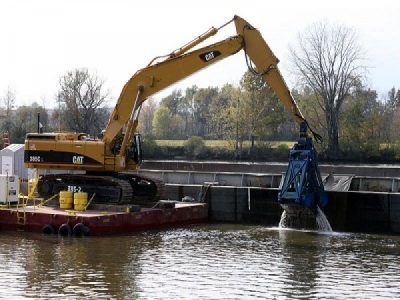
Posted on January 11, 2018
By Allison Dunne, WAMC
The U.S. Environmental Protection Agency has informed General Electric that its decision about whether to formally determine that the Upper Hudson River PCB cleanup is complete is delayed. Meantime, the U.S. Fish and Wildlife Service sent a letter to the EPA, saying additional cleanup would accelerate recovery of the river and its resources.
EPA received GE’s Remedial Action Completion Report, in which GE requested EPA’s Certification of Completion, January 3, 2017. The agency had one year to respond. But in its January 2, 2018 letter to GE, it says that it is not ready to respond because it is has not yet finalized its second Five Year Review report for the Hudson River PCBs Superfund site, which it had wanted to do before deciding whether the PCB cleanup is complete. GE Spokesman Mark Behan says EPA recently did advise that it would need a bit longer to complete its five-year review report.
“It expects to do so shortly and then will consider GE’s application for Certificate of Completion,” Behan says. “And we look forward to EPA promptly completing and issuing both documents.”
EPA explains in the letter that completing the five-year report is taking longer than anticipated, given the number and complexity of comments submitted during the public comment period. EPA said last year that the review does conclude that the $1.7 billion, six-year cleanup is working, and will accomplish its long-term goal of protecting human health and the environment when complete. EPA in its letter also notes that it has received comments on GE’s certification request from the federal trustees and New York state, and requires additional time to carefully consider these comments. One of the federal trustees is the U.S. Department of the Interior’s Fish and Wildlife Service, where Kathryn Jahn is Hudson River Case Manager. Jahn signed a December 2017 letter to EPA.
“As we note in our letter, additional PCB removal and robust habitat reconstruction under the CERCLA, the Superfund remedial program, will accelerate the recovery of the river and its resources, which reduces the restoration that’s required, which facilitates the overall recovery, which is our goal, and EPA’s goal and our co-trustees’ goal, successful recovery of the Hudson River,” Jahn says.
NOAA, the National Oceanic and Atmospheric Administration, is the other federal trustee and New York, the state trustee. Ned Sullivan is president of Poughkeepsie-based Scenic Hudson, which has long called for more dredging.
“Well, we’re very pleased that the U.S. Fish and Wildlife Service has reaffirmed its position that additional cleanup is needed, that it would accelerate the recovery of the river,” Sullivan says.
GE’s Behan responds to the calls for additional dredging.
“There really is no dispute that the dredging project was a success. PCBs measured in the river at every environmental monitoring station have declined since dredging. All of the PCBs that EPA targeted for removal have been removed,” says Behan. “EPA has called the project a success and has determined that it will protect human health and the environment going forward.”
During his State of the State address January 3, New York Governor Andrew Cuomo reiterated his vow from December to take legal action should the EPA deem the cleanup complete.
“The Hudson River is one of our greatest and most scenic waterways in the nation. For many years, General Electric polluted the river with PCBs. There has been progress made in cleaning it up but the job is not done,” Cuomo said. “So if the federal government releases GE saying the cleanup is complete, I’ll tell you what this state is going to do. We’re going to sue the federal government to stop it because we will not end our efforts until our future generations can once again fully enjoy the beautiful Hudson River.”
Again, Scenic Hudson’s Sullivan.
“So we’re hopeful, I am hopeful, that EPA will heed the calls of all the trustees, federal and state, and avoid the litigation that the governor and attorney general are very explicitly stating will occur if they do the wrong thing,” says Sullivan. “We don’t want to see litigation. We want to see a clean river.”
General Electric removed 2.65 million cubic yards of contaminated sediment from a 40-mile stretch of the upper Hudson through 2015. Jahn says her agency continues to be concerned about the significant PCB contamination left in the Hudson River.
“Well, as trustees, what we are doing is pursuing damages from GE to restore the injured natural resources. An example of an injury is the consumption advisories that have been in place for fish for the Hudson River for decades, and those advisories will continue for decades because of the residual PCB contamination,” says Jahn. “So, as trustees, we’ll be looking at restoration options to put back those lost uses.”
EPA officials say that in 15 years, people will be able to safely eat one fish meal every two months and that it likely will be more than 55 years before all local species of fish are clean enough to eat once a week.
Source: WAMC





